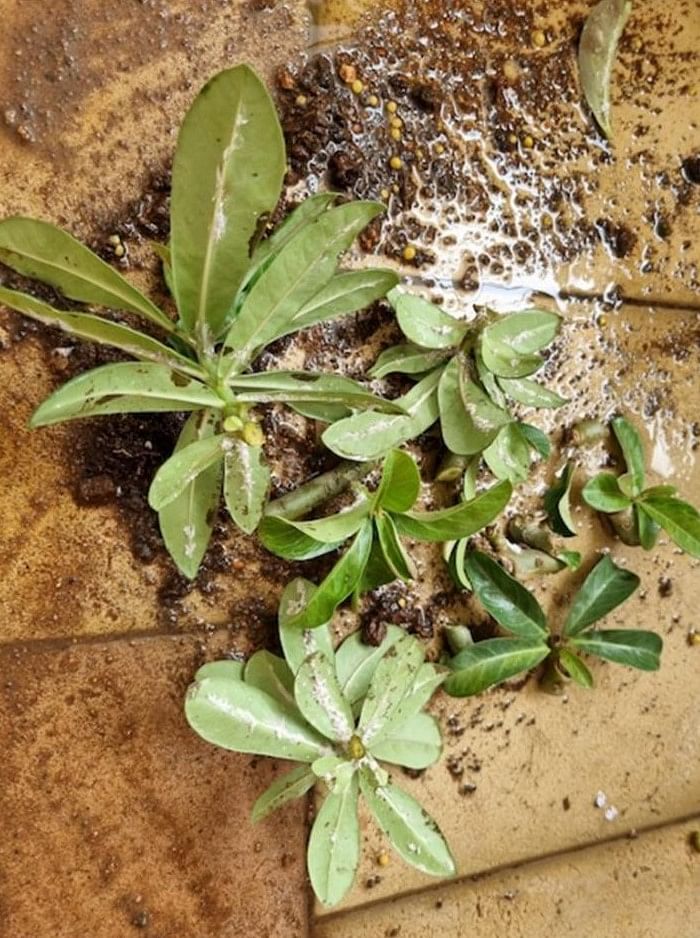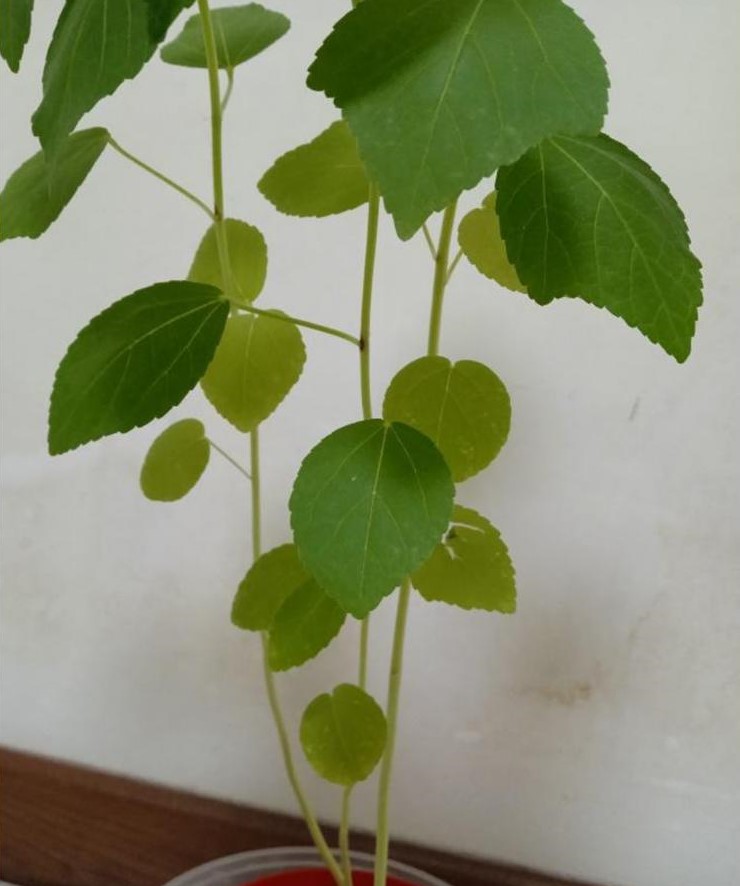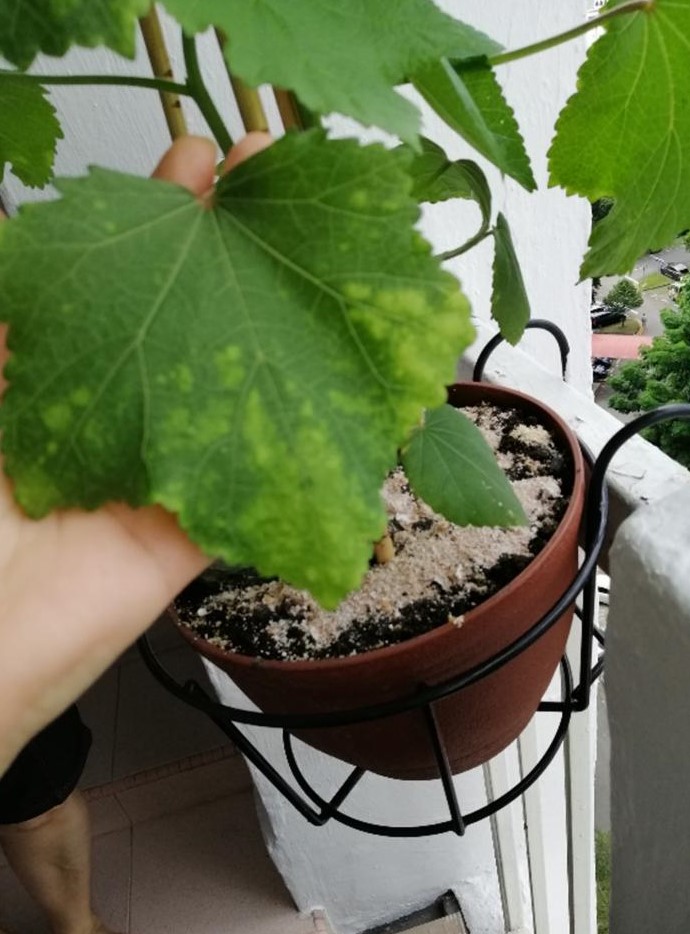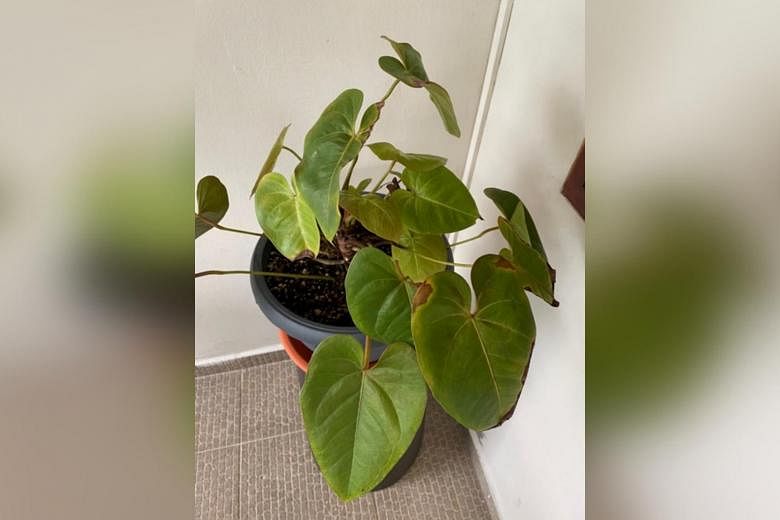Anthurium grows best in a location with filtered sunlight
This plant was growing well until a few months ago. I took it out of the sunlight, but the stem still seems unhealthy. What plant is it?
Cheryl Tan
The plant is likely an Anthurium species - possibly a Flamingo flower cultivar, which produces attractive inflorescences that have a colourful sail-like spathe with a rod-like spadix containing the plant's actual flowers.
It cannot be grown in deep shade and a lack of light can gradually lead to a host of problems, such as making the plant more vulnerable to pests and disease. You may want to move it to your balcony or corridor where it can get at least four hours of filtered sunlight a day.
The growing medium should not be too heavy and, ideally, be aerated and moisture-retentive. Let it dry out slightly so that the plant's roots and crown do not rot.
Be thorough, consistent in battling mealy bugs

My desert rose plants are infested with mealy bugs. It started from one pot and spread to three others. Neem oil did not work, so I pruned all the leaves. But the bugs return when new leaves appear. What should I do?
Tan Swee Cheng
Common organic pesticides cover and suffocate existing pests on infested plants. Hence, thorough coverage is essential, especially on the undersides of leaves and in tight corners such as leaf axils. Repeated applications and regular inspections are required to deal with new or remaining pests. Ants may bring mealy bugs, so you may need to keep them in check as well.
Pest management requires a multi-pronged approach. You may want to rotate among a number of pesticides to ensure adequate control. Consider using pyrethrins that are derived from insecticidal chrysanthemum flowers, as well as microbial pesticides based on entomopathogenic fungal species, such as Beauveria bassiana and Metarhizium anisopliae.
Roselle plant may need more light and fertiliser

The leaves at the bottom layer of my roselle plant have turned a lighter shade of green and have spots. What is the reason - and remedy - for this?
Huang Jiahui
Your plant looks quite stretched, which is a sign that it is not getting enough sunlight. Roselle plants grow best in a location with at least six hours of direct sunlight a day.
Try moving your plant to a larger pot for better growth. Aim for a plant each 30cm pot for best results.
The change in hue may indicate a lack of fertiliser, especially nitrogen, which plants need during their rapid growth phase. You can use either organic or inorganic fertiliser pellets to feed your plant to ensure nutrients are given at the same pace as the plant's growth rate. Always follow the application instructions on the labels as overfeeding your plant with fertiliser may burn it.
Lady's finger plant may have fungal disease

Why have the leaves of my lady's finger plant developed discoloured patches? Is it due to a fungal disease? The plant was propagated by seeds.
Vanda Cheong
Your lady's finger plant likely has a fungal disease, probably mildew. It is a common occurrence if plants are grown too closely to one another, in a shaded area and during the rainy season.
Prune the affected leaves and apply a fungicide to manage the disease's spread. Follow the label's instructions in making the appropriate concentration to spray on the plant. Be sure to observe the withholding period (the minimum length of time that must pass between applying fungicide and harvesting fruit for consumption). Wash fruit thoroughly before cooking and eating it.
You can also consider growing disease-resistant varieties during a hotter and drier time of year. Ensure plants are adequately spaced out.
Cacti needfull sunlight and a well-drained location

I saw that some species of edible cacti can be grown outdoors. I would like to grow them in a semi-shaded area, both as an edible and an ornamental houseplant.
After first harvesting the pads, should the rest of a cactus be left behind to continue regeneration for a certain number of harvesting cycles? Thereafter, can the cactus be replanted from the harvested pads? I am not sure if this species can be propagated this way.
I also noticed that the pads can lose their deep, verdant green hue and turn greyer. Is this a sign that the plant has aged and replanting is necessary? Also, can this edible cactus produce fruit?
Tio Boey
In general, cacti are not shade-tolerant. Even in semi-shade, most species will not fare well. They will produce elongated and soft growth that is not visually appealing and will be more vulnerable to pests and diseases.
Edible cacti can produce fruit, but only large, mature plants that are left to grow will flower and fruit. Cacti that are constantly harvested for their pads will normally not do so.
The edible cactus pictured is Nopalea cochenillifera. It should be grown and harvested such that each pad is severed at the base that connects it to another pad below. This creates a small wound that will heal easily.
Do not overharvest a cactus' pads. Take only one or two, depending on the plant's size, so the plant has the chance to regenerate. Commercial farms grow a large number of plants for this purpose; plants usually do not grow that quickly. New cacti can be propagated by planting a pad that has been harvested.
The greyed-out parts of the plant could be due to scarring from infestation by scale insects or a physiological disorder called oedema, which is a result of wet, poorly drained soil. This can occur during the rainy season in open areas.
- Answers by Dr Wilson Wong, an NParks-certified practising horticulturist, parks manager and ISA-certified arborist. He is the founder of Green Culture Singapore and an adjunct assistant professor (Food Science & Technology) at the National University of Singapore.
- Have a gardening query? E-mail it with clear, high-resolution pictures of at least 1MB, if any, and your full name to stlife@sph.com.sg. We reserve the right to edit and reject questions.
- Sign up for free gardening talks by Dr Wilson Wong on Saturday, Jan 22: Grow Your Own Lady's Fingers (2 to 2.45pm, register at str.sg/wMd6), Online Gardening Q&A For Jan 2022 (3 to 3.45pm, register at str.sg/wMdu) and Create Your Own Decorative Table Displays For Lunar New Year (4 to 4.45pm, register here).

